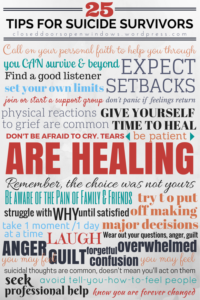Ways to help survivors cope with their loss and grief include:
- Be available – Listen if they want to talk. Don’t try to fix things. Your presence is comforting even if you do not speak. Ask IF and HOW you can help. Be patient.
- Normalize the grief – Survivors should grieve just as they would any other loss. Validate their feelings.
- Encourage openness – Use the loved one’s name. Extend your condolences. Don’t avoid talking about the person who is gone.
- Ease guilt – It may help to remind the survivor how little control anyone has over another’s behavior, and how even professionals cannot predict when such a death might occur.
- Plan ahead – Help the survivor find ways to cope with upcoming special events and calendar dates which will be difficult.
- Make connections – Give information on support groups and resources specific to survivors of suicide loss.



